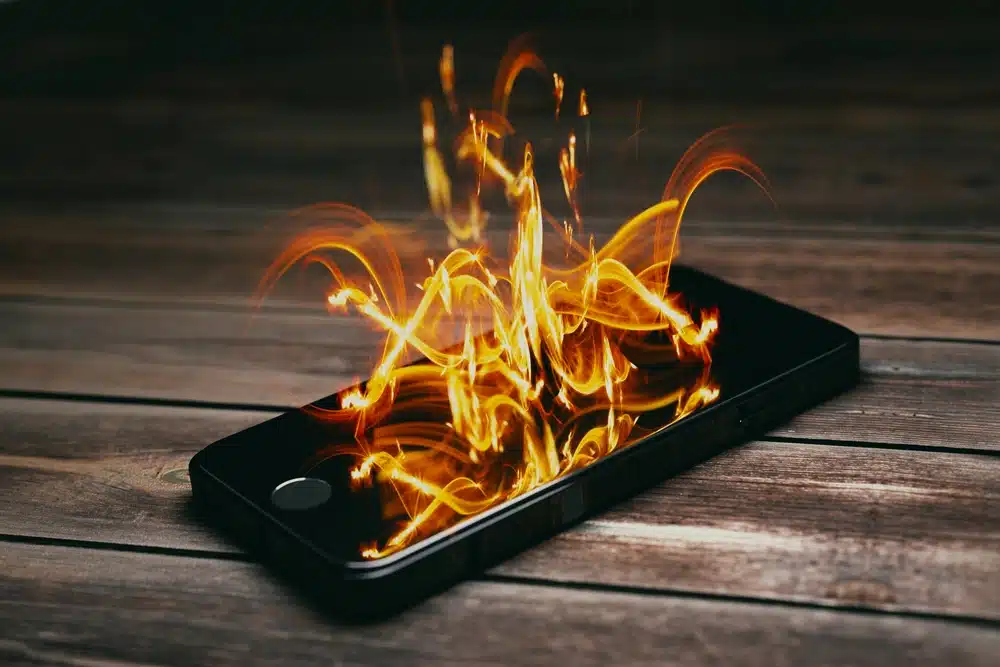In this article, we will delve into why lithium batteries catch fire, the main causes behind the accidents, and how we can avoid the risk of fire.
Table of Contents
ToggleWhy do lithium batteries catch fire

There is a core concept behind lithium battery fires, thermal runaway. It is like a domino, when the first one falls, the rest will fall one after another, forming an uncontrollable chain reaction. The temperature rises sharply, and the energy inside the battery is violently released in a short period of time. The consequences of this can be serious, from the battery smoking, spewing flammable gases, to fire, and even small explosions.
Below are possible reasons why the domino effect occurs in lithium batteries:
- Manufacturing defects: tiny impurities may be mixed into the battery or internal defects may exist during production, which may cause internal micro short circuits.
- Physical damage, such as your mobile phone or electronic device accidentally falling to the ground, or the battery being pierced by a sharp object, may damage the internal structure of the battery and directly cause a short circuit.
- Improper charging may cause the battery to be overcharged, exceeding the safe voltage of the battery. Or using a low-quality, incompatible charger may cause unstable voltage and current to the battery, which can easily damage the battery.
- High temperatures, such as in a car or garage on a summer day, can also speed up unstable chemical reactions inside the battery.
- This is also prone to happen to aged batteries. As batteries are used for a long time, just like people age, the internal performance of the battery will degrade and the risk of internal short circuits will increase.
How to prevent lithium battery fire
Now that we have discussed the causes of battery fires, how can we effectively avoid them? Here are some practical measures.
Follow the charging safety rules and insist on using the original charger or certified chargers, which can provide stable voltage and current, and have built-in protection circuits to avoid overcharging risks. Avoid long-term overcharging. Even if the current charger has an overcharge protection function, it is recommended that you unplug the connector in time after fully charging. It is a very practical safety habit not to charge for a long time when unattended.
Good daily usage habits. Use with care, do not drop, squeeze, or puncture the battery. Keep away from high temperatures, do not expose the device to the sun in a hot car, or near a heat source. If the battery is found to be swollen or leaking, stop using it immediately. Choose a cool and dry environment for storage, and do not store it together with metal.
Of course, it is best to choose high-quality batteries from reputable factories to reduce the risk of manufacturing defects. At the same time, avoid choosing batteries that are too cheap, which may very well be low-quality counterfeit products.
Finally, do not modify or disassemble the battery by yourself. Please seek guidance from a professional.
Identify battery fire signs
So how can we detect the signs of battery fire in time before potential danger occurs? Before the battery is completely out of control (thermal runaway), it usually shows some abnormal signs. The following are some specific abnormal phenomena.
The battery and device are abnormally hot. Even without intensive use (such as playing large games or fast charging), the device or battery is still hot to the touch.
The battery starts to bulge and deform, which is a very typical and dangerous signal. If the back of your device suddenly bulges, it usually means that the battery has failed internally, producing gas and is very unstable.
The battery shell is damaged and leaking. If you see obvious cracks or damage on the battery shell, or liquid is leaking, this directly indicates that the physical structure of the battery is damaged and the risk is extremely high.
Emit a pungent smell. When an abnormal chemical reaction occurs inside the lithium battery, it may release a special, pungent chemical smell.
The device is charging and discharging abnormally, and performance drops suddenly. The battery suddenly stops charging, loses power very quickly, or the device performance drops significantly for no apparent reason.
If you notice any of these signs, stop using the battery and device immediately. Don’t take chances.
What to do in case of fire

What if your battery or device catches fire? How should you handle it carefully?
The first principle is to ensure personal safety. Any property loss cannot compare with life safety.
If the battery starts to smoke or have a small flame, you can try to put out the flames with sand. If you have a Class D fire extinguisher designed for lithium batteries, that would be even better.
If the fire is large, evacuate to a safe area and call the fire department immediately. It is best to clearly state that the fire was caused by a battery and the specific address.
Do not pour water directly on burning small electronic devices, as water may react with lithium and increase the danger. Water can be used to cool down and prevent the fire from spreading to the surrounding area.
Safe disposal of used batteries
Don’t throw used batteries directly into the trash can. During the compression and transportation of garbage, there may be a risk of short circuit or even fire.
Lithium batteries contain heavy metals and chemicals. Careless disposal can seriously pollute soil and water sources. Proper recycling can not only avoid pollution, but also recycle the valuable metal resources in them.
Conclusion
Lithium battery fires are not without cause. They are usually related to physical damage to the battery, improper use, and manufacturing defects. Battery fires are likely to be avoided through correct behavioral habits. Scientific charging methods and usage habits are the fundamental way to prevent lithium battery accidents.
